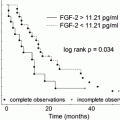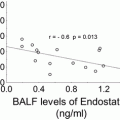Fig. 1
Clinical characteristics of patients with Hashimoto’s thyroiditis
3.2 Physical Examination and Ultrasound
The most frequent finding in HT children was a firm thyroid gland on palpation: in 44 (98 %) out of 45 patients. The goiter was found only in 24 (53 %) patients. Symptoms of hypothyroidism: bradycardia, dry skin, increased fat tissue, and apathy were present only in 5 children in whom hypothyroidism was confirmed by laboratory tests. In ultrasound examination, thyroid volume exceeded 97th percentile for age and sex in 23 (51 %) out of the 45 patients, but 100 % of children had diffuse hypoechogeneity of the thyroid gland (Fig. 1).
3.3 Laboratory Tests
Primary hypothyroidism in laboratory tests was confirmed in 5 (11 %) out of the 45 patients at the time of diagnosis. The TSH value was between 42.7 and 82.4 mIU/L in five hypothyroid children. All children were positive for anti-TG antibodies; the mean anti-TG concentration was 366.7 ± 565.3 IU/L, the median was 160.0 IU/L, and the range was 39–2,185 IU/L. The anti-TPO antibodies were found in 41 out of the 45 HT children (91 %); the mean anti-TPO concentration was 626.8 ± 770.0 IU/L, the median was 336.6 IU/L, and the range was 80–2,429 IU/L.
3.4 Cytometric Evaluation of Peripheral Blood Mononuclear Cells (PBMC)
The PBMC subsets CD4+ CD8+ and the co-stimulatory molecules CD152+ and CD28+, which play a key role in T cell activation, were evaluated. Percentages of CD4+ did not differ between the HT and healthy children at baseline before stimulation, amounting to 23.7 ± 10.1 % and 23.9 ± 9.6 %, respectively. Likewise, CD8+ were not different either; 16.6 ± 8.3 % vs. 17.0 ± 5.9 %, respectively (Table 1). The percentage of CD8+ PBMC was not influenced by stimulation in either group of children. Stimulation had a differential effect on the CD4+ cells; they remained at a similar level in the HT children, but decreased significantly in the healthy children, from 23.9 ± 9.6 % before to 15.6 ± 5.1 % after stimulation (p < 0.05).
Table 1
Percentages of different subpopulations of peripheral blood mononuclear cells (PBMC) before and after stimulation with phytohemagglutinine (PHA) in Hashimoto’s thyroiditis (HT) and healthy children
PBMC surface phenotype (CD) | PBMC before stimulation | PBMC after stimulation | ||
|---|---|---|---|---|
HT children | Healthy children | HT children | Healthy children | |
CD4+ | 23.7 ± 10.1 | 23.9 ± 9.6* | 21.8 ± 11.4# | 15.6 ± 5.1*# |
CD8+ | 16.6 ± 8.3 | 17.0 ± 5.9 | 12.2 ± 5.7 | 14.2 ± 4.4 |
CD4+CD28+ | 20.6 ± 9.6* | 21.1 ± 9.5* | 8.5 ± 5.1* | 6.7 ± 2.8* |
CD8+CD28+ | 8.0 ± 5.0* | 7.9 ± 3.5* | 2.8 ± 2.1* | 3.6 ± 0.9* |
CD4+CD152+ | 1.0 ± 0.8*# | 2.5 ± 1.6*# | 2.9 ± 1.8* | 3.4 ± 1.4* |
CD8+CD152+ | 1.2 ± 1.6# | 2.5 ± 2.0*# | 2.0 ± 1.5# | 4.0 ± 1.5*# |
Percentages of CD4+ CD28+ cells decreased about uniformly after PHA stimulation in both HT and healthy groups: from 20.6 ± 9.6 % to 8.5 ± 5.1 % and from 21.1 ± 9.5 % to 6.7 ± 2.8 % (p < 0.05), respectively, so that there were no differences in the values of CD4+ CD28+ cells between the two groups of children either before or after in vitro stimulation. The subset of CD8+ CD28+ cells changed in response to PHA stimulation in like manner (Table 1).
The percentage of PBMC with the surface expression of CD4+ CD152 was lower in the HT children than that in the healthy children; 1.0 ± 0.8 % vs. 2.5 ± 1.6 %, respectively (p < 0.05). After PHA stimulation, the percentage of CD4+ CD152 cells increased in the HT, from 1.0 ± 0.8 % to 2.9 ± 2.1 %, (p < 0.001), as well as in healthy children, from 2.5 ± 1.6 % to 3.4 ± 1.4 % (p < 0.05). The increase in CD4+ CD152 cells in response to stimulation was more than twofold greater in the HT children, leveling off the significant differences between the two groups of children present at baseline before stimulation (Table 1).
Finally, the percentage of CD8+ CD152+ also was significantly lower in the HT children compared with the healthy controls at the baseline; 1.2 ± 1.6 % vs. 2.5 ± 2.0 %, respectively (p < 0.05). Here, PHA stimulation doubled the values of CD8+ CD152+ cells in both groups of children, so that the significant difference between the two groups was sustained; 2.0 ± 1.5 % vs. 4.0 ± 1.5 % (p < 0.05) in HT and healthy children, respectively (Table 1).
3.5 Correlations Between the Level of Autoantibodies and the Lymphocyte Phenotype
The levels of anti-TPO and anti-Tg antibodies were higher in the children with a lower percentage of CD + PBMC cells expressing CD152+ on the surface, but only an association between anti-Tg antibodies and the relative number of CD152+ PBMC reached significance (r = −0.34, p = 0.04). The hormonal function of the thyroid did not correlate either with T cell phenotypes or anti-thyroid antibody concentrations.
4 Discussion
Hashimoto’s thyroiditis is a multifactorial and heterogeneous disease. Genetic and environmental factors are known to interplay in the onset and progression of the disease. In the examined group, a significant female predominance in the development of the disease was found, which is consistent with other authors’ opinion, irrespective of the ethnic origin of patients. However, the reason for this female predominance is incompletely understood. Hormonal status, genetic and epigenetic differences, and lifestyle have been considered to explain the female predominance in HT. Sex hormones also play a determinant role in the HT pathogenesis. Sex-related differentiation of the immune system is not only dependent on steroid influence (Pennel et al. 2012), but also on the genes located on the X chromosome and its skewed inactivation (Quintero et al. 2012). Recently, Y chromosome’s protective function against autoimmune diseases also is being considered (Persani et al. 2012).
Stay updated, free articles. Join our Telegram channel

Full access? Get Clinical Tree





